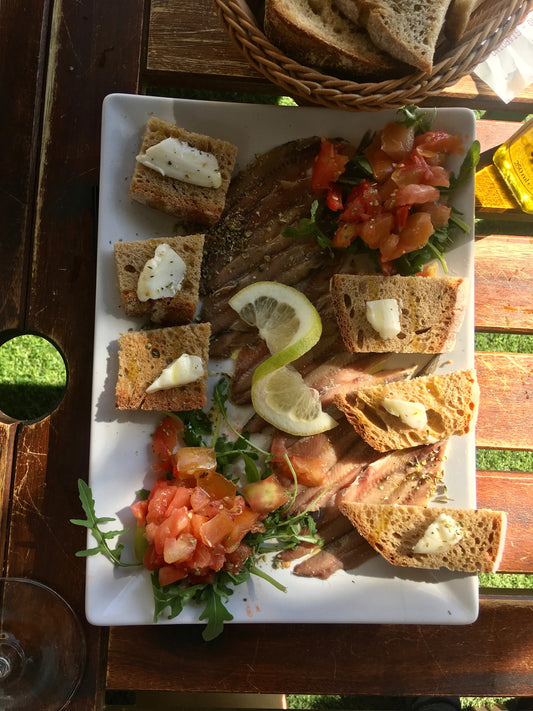
History of Salt: From selmelier and James Beard Award winning author Mark Bitterman
Salt is the prism through which the ingredients, dishes, and people of the world can be experienced in all their fullness and variety. This may sound like hyperbole, but sprinkle the parchment fine flakes of Maldon sea salt on home-grown butterleaf lettuce dressed in macerated shallot vinaigrette and you will experience a chlorophyll dynamo of flavor that seems to strum at the very heart of nature. Patter the pink flesh of fresh-caught trout with the stratified lacework flakes of Halen Môn and brace yourself against the sure compulsion to make offerings of hekatombs and burnt flesh to the sea god Poseidon. Let fall dark crystals of Black Diamond Pyramid salt on medallions of Armagnac-seared pork and plantains and you will feel the turgid rush of Incan discovery. Grind smoked salt on hand-churned ice cream and you will trade your house for an igloo. Salt sates the Alchemist’s desire, transmuting food to fantasy.
The salting of food predates even cooking, as earliest man recognized the unrivalled culinary importance of the salt crystals forming naturally by the seashore, or the salt rocks sought out by other animals in the nearby hills. By the time humans had developed language, the use of salt with food was already commonplace.
In Iranian legend, Hushang succeeded his grandfather Kayumars as the first of the Pishdadian Kings while still a youth. Returning from a hunting expedition one cold day, Hushang encountered a snake coiled on a rock and tried to kill it with a throw of his ax. However, the young man’s aim was off and the flint-ax struck the rock, sending bright sparks into dying embers of the evening sky. The discovery of fire brought all the benefits of the fire god Hephaestus’ trade, including the smithying of iron and all attendant technologies, from swords to frying pans.
What the legend does not tell is that salt was almost certainly the economic pillar of the Pishdadian empire by the time this discovery was made. No one knows whether the practice of salting meat originated with religious rites, as an experiment with flavor, or with some chance observation of its curative properties—but it was this last use upon pivoted which the whole of human civilization.
Salt could be used for the curing and preservation of fish and meats, and later, in the baking of bread. Food preservation allowed for provisioning during winter months and dry seasons, bringing stability and health to societies, and strengthening them against attack by others. Stability and security allowed larger groups of people to live together, increasing social complexity and accelerating the rate of human progress. Salt-preserved foods also permitted the formation of trade networks across sea and land, bringing wealth, cultural diversity, and culinary discovery to rising nations. Salting was, in short, what enabled mankind to rise above his animal self, to think strategically about his survival and begin exploring the greater world around him.
While our ancient ancestors may have been preoccupied with the use of salt for preserving food—perhaps in some instances even to the detriment of flavor—the practice of using salt judiciously to enhance and improve flavor has existed on for thousands of years. As agriculture and animal husbandry progressed and trade expanded, the diversity and quality of ingredients improved. The art of interplaying disparate flavors evolved to the point where great culinary traditions took shape.
Salt as food’s most effective flavor enhancer
The use of salt strategically, as an ingredient with distinct physical properties and culinary traditions, finds its fullest expression in finishing salt. The combination of mineral content, residual moisture, and crystal structure gives salt infinitely varied and uniquely complex behaviors of different foods. You can't consider the power of salt separate from the food it is seasoning, any more than can separate fire from the food it is cooking.
Exotic salts are staging an extraordinary comeback, regaining ground lost to industrial salt manufactures in the late 1800s. Once again you can find a variety of quality salts. However, the abundance of crazy-looking, exotically-named salts has not always redounded to the benefit of the meal. To a large extent, the true potency of finishing salts remain shrouded in hype and hullabaloo, and even a certain materialism—as the entrancing crystalline cosmology of a sublime finishing salt appeals to our jay-bird love of all things golden bright and gemstone shiny.
Most finishing salts come from the sea. We take great care to select every sea salt with an eye to the purity of the water source from which the salt came, and the few quarried salts we carry are exclusively hand-harvested. As a result, our finishing salts are unrefined yet pure, produced in ways that are complimentary and respectful of the environment, local economies, and regional culinary traditions.
Read Salt 101 >







